Abstract
In order to discern the effect of rare earth element Er addition on grain refinement of the most widely used titanium alloy Ti6Al4V, new erbium modified Ti6Al4V alloys with compositions of Ti6Al4V-xEr (x = 0, 0.2, 0.4, 0.6 wt %) were developed and investigated for their microstructural characteristics and mechanical properties in comparison with their unmodified baseline alloy. Microstructural examinations revealed that, by adding Er, (1) the microstructure primarily retained a two-phase structure consisting of α and β, (2) remarkable grain refining occurred, and (3) some Er2O3 and Al2Er disperses were formed largely around the β phase and near the grain boundaries. Mechanical property measurements evidenced an overall enhancement under tension and hardness tests. An increase in both strength and plasticity with increasing Er content was obtained but followed by a drop, while a gradual monotonous improvement in hardness was achieved. The Ti6Al4V-0.2Er alloy exhibits optimal mechanical properties.
1. Introduction
Due to low density, high specific strength, high corrosion resistance and high temperature stability, titanium alloys are been used as structural materials in aerospace, mechanical manufacturing and biomedical industries [1,2,3]. Titanium alloy components are widely fabricated by forging, and some difficulties are encountered in the processing of titanium alloys, such as poor processability and low comprehensive utilization. However, in many cases, workpieces with complex structures could be manufactured by precision casting, such as large complex thin-walled titanium castings for aerospace applications. The precision casting technology has the advantages of good surface roughness and high dimensional accuracy of the castings, which can significantly improve the utilization rate of raw materials (up to a range of 75% to 90%) and reduce the machining cost. Therefore, the understanding of the as-cast microstructure of titanium alloys is of technological importance to control the microstructural characteristics and thus understand the performance of the casting.
It’s well known that the mechanical properties of titanium alloys are very much governed by their microstructures, in particular, the size of β grain, the morphology and distribution of α phase, etc. The relation between yield stress and grain size is described mathematically by the Hall–Petch equation [4]. With the decrease of grain size, the strength and hardness of the material increase gradually, and the plasticity increases with the decrease of grain size and lamellar spacing [5]. However, the crystal growth rate of melt solidification of titanium alloy outperforms the nucleation rate, making the casting favor forming coarse grain structure. As the casting thickness increases, the grain size increases abruptly, which in turn deteriorates the casting mechanical properties such as strength, plasticity, fatigue resistance and fracture [6,7]. The most widely used approaches for controlling the microstructures and improving mechanical properties of casting titanium alloys are alloying (and/or microalloying), heat treatment, thermo-mechanical process, etc. [8]. Although fine grains of titanium alloys can be obtained by cyclic heat treatment or thermomechanical process, the former is limited by sample size and is prone to annealing micro-cracks during heat treatment, while the latter is complex and difficult to achieve.
In recent years, grain refinement technology of titanium alloy castings has attracted extensive attention [9]. By grain refinement, not only the specific strength, toughness and plasticity of alloys as well as the service life of components can be improved, but the weight and size of components can also be reduced [10,11,12,13]. As core ingredients to refine the grain size and control the microstructure, rare earth (RE) elements have been investigated in a great number of metallic material families to improve versatile mechanical properties [14,15]. Moreover, RE elements could be also utilized as surface-active agents. It is well known that REs reduce the surface tension of a crystal nucleus thus increasing the nucleation probability and nucleation rate on one hand, enhancing the diffusion activation energy of crystal nucleus and preventing the growth of crystal nucleus on the other hand. Liu et al. [16] showed that a small amount of Y obviously refined the grain size of Ti-6Al-2.5Sn-4Zr-0.7Mo-0.3Si alloy and contributed to the improvement of the microhardness and the compression properties. Y2O3 oxide particles were found to form and uniformly distribute within the β grain of Ti-6Al-2.5Sn-4Zr-0.7Mo-0.3Si-Y. Xiao et al. [17] found that the room temperature and high temperature tensile strength of Ti6.6Al5.5Sn1.8Zr-based alloys gradually improved with the increase of additional Sc at the expense of plasticity. Ke et al. [18] reported that the compressive property of Ti–Al–Nb intermetallics can be improved by an Er additive because of the presence of fine (AlTiNb)2Er3 precipitates in the β phase. Whitsett et al. [19] found that 0.1 wt % Er effectively affects grain refinement of Ti-6Al-4V but no mechanism of refinement was clarified. Accordingly, this work aims to investigate the effect of the addition of trace Er element on the microstructure and mechanical properties of the casted Ti6Al4V alloy and perform a mechanistic study.
2. Materials and Methods
Four different alloys with the nominal compositions Ti6Al4V-xEr (x = 0, 0.2, 0.4, and 0.6, wt %) were prepared in this work. Starting with titanium sponge, aluminum vanadium intermediate alloy and pure erbium (purity > 99.99%) all the alloys were melted by the vacuum cold crucible levitation melting approximately at 1820 °C for 3 minutes under an Ar atmosphere. The ingots had been reversed and re-melted seven times to ensure chemical homogeneity.
The phase identification of the alloys was analyzed by X-ray diffractometry (XRD, DMAX-RB, Rigaku, Japan) using Cu Kα radiation (λ = 0.15406 nm) with scanning speed at 4°/min. Microstructural characterization was carried out by using optical microscopy (OM, Axio Observer A1m, ZEISS, Germany), scanning electron microscopy (SEM, VEGAII-XMH, Tescan, Czech Republic), and transmission electron microscopy (TEM, TECNAI G20, FEI, Hillsboro, OR, USA), where chemical compositions were analyzed by using energy-dispersive spectroscopy (EDS, Oxford Instrument Co., Ltd., Oxford, UK). Average grain size and micro-lamellar tissue size were performed by Image Pro Plus (ver 6.0, Media Cybernetics, MD, USA) image analysis software. Samples for OM and SEM observations were cut from as-cast alloys and prepared by mechanical polishing, and then etched about 8s by a solution with 10 vol % hydrofluoric acid and 20 vol % nitric acid. Specimens for TEM observation were prepared using twin-jet electro-polishing with a solution containing 5 vol % HClO4, 35 vol % 2-butoxyethanol and methanol at −15 °C and 20 V. The Vickers hardness of the alloy was measured on a HV-1000 (Laizhou Huayin, Laizhou, China) micro Vickers hardness tester. The mechanical properties were evaluated by tensile testing. Dumbbell-shaped samples with a gauge section 3.0 mm in diameter and 33.0 mm in length were machined from the as-cast alloys. Tensile tests were carried out on YYF-50 (Bairoe, Shanghai, China) mechanical testing machine. The samples were designed under GB/T228.1-2010 metal materials tensile test standard.
3. Results
3.1. Microstructural Characteristics
Figure 1 presents the X-ray diffraction patterns of the Ti6Al4V-xEr alloys with different Er additions. It was found that all alloys were composed of α phase and β phase, that is, the typical duplex phase microstructure of the Ti6Al4V alloys. No RE-enriched phase was detected by the X-ray diffraction due to a low phase fraction of the Er-enriched phase in these alloys. Due to the small amount of Er addition, neither the compositions nor partitions of the α and β phases were subjected to more than minor changes. A phase fraction analysis from the XRD pattern in Figure 1 shows that the volume fraction of the β phase increased with increasing Er content, suggesting Er as a β stabilizer.

Figure 1.
X-ray diffraction patterns of Ti6Al4V-xEr casting alloys.
The microstructure of Ti6Al4V-xEr casting alloys are displayed in Figure 2. As shown in Figure 2a, the microstructure primarily featured with coarse β grains in the Ti6Al4V baseline alloy, whereas the β grains remarkably shrink in size in Figure 2b–d as the Er content increased up to 0.6 wt %.
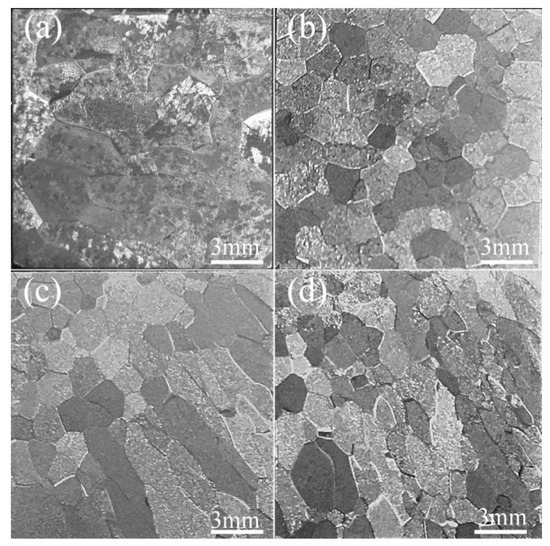
Figure 2.
The microstructures of Ti6Al4V-xEr casting alloys: (a) x = 0; (b) x = 0.2; (c) x = 0.4; (d) x = 0.6 wt %.
In more detail, Figure 3 illustrates the grain size distribution of distinct as-cast Ti6Al4V-xEr alloys. It is in the Ti6Al4V baseline alloys (see Figure 3a), 29% β grains ranged 2.0–2.5 mm, and 16% were in the range of 2.5–3.0 mm and 3.0–3.5 mm, respectively. With 0.2 wt % Er addition in Figure 3b, the β grain size peaked in the range of 1.2–1.4 mm. The peaks shifted to 1.0–1.2mm with 0.4 wt % Er, and further down to 0.7–0.9 mm for about 53% of the β grains when Er was up to 0.6 wt %.
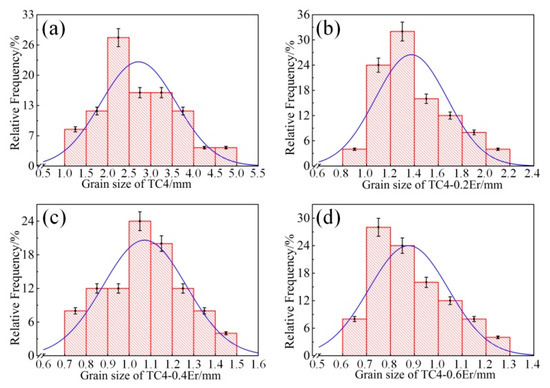
Figure 3.
Size distribution of the β grains of Ti6Al4V-xEr casting alloys: (a) x = 0; (b) x = 0.2; (c) x = 0.4; (d) x = 0.6 wt %.
Figure 4 shows the optical micrographs of as-cast Ti6Al4V-xEr alloys. It was revealed that all alloys exhibited coarse Widmanstatten structure. Large α platelet colony clusters formed within the prior β grains whose prior grain boundaries remained clearly visible. Through a phase transformation from β to α phase by the cooling process, there exists a strict Burgers orientation relationship between the α and the β phase [20], where the α laths align parallel to each other that gives rise to the lamellar structure in the α colonies. It can be found in Figure 4 that the ratio of length to width of the α laths with the lamellar colonies increased with the increase of Er.
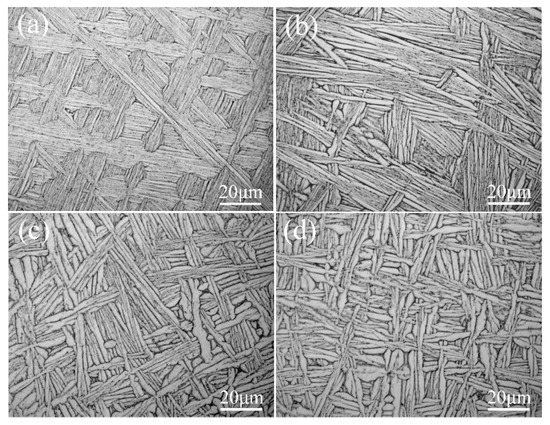
Figure 4.
The optical micrographs of Ti6Al4V-xEr casting alloys: (a) x = 0; (b) x = 0.2; (c) x = 0.4; (d) x = 0.6 wt %.
Figure 5 and Figure 6 display the size distributions of the length and width of α laths in lamellar microstructure of Ti6Al4V-xEr casting alloys, respectively. The length and width of α lath of the Ti6Al4V baseline alloys were found to peak approximately at 14 μm (Figure 5a) and at 0.8 μm (Figure 6a), respectively. When adding 0.2 wt % Er, the distribution of the length shifted the peak to 12 μm (Figure 5b) and the width to 1.7 μm (Figure 6b). Further increasing Er to 0.4 wt %, the peak of the lath length moved to 10 μm (Figure 5c) and the width to about 2.0 μm (Figure 6c). Up to 0.6 wt % Er, the lath length peaked at 12 μm (Figure 5d) and the width at 2.2 μm (Figure 6d). In brief, by increasing Er content, the α lath length of Ti6Al4V-xEr casting alloys decreased while the width increased.
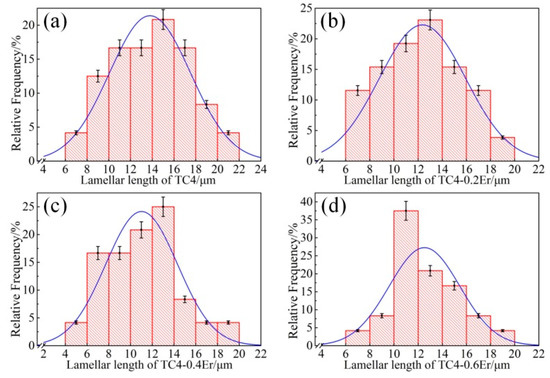
Figure 5.
Size distribution of the lamellar length of Ti6Al4V-xEr casting alloys: (a) x = 0; (b) x = 0.2; (c) x = 0.4; (d) x = 0.6 wt %.
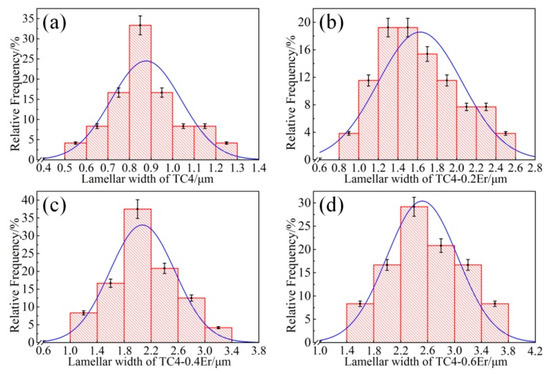
Figure 6.
Size distribution of the lamellar width of Ti6Al4V-xEr casting alloys: (a) x = 0; (b) x = 0.2; (c) x = 0.4; (d) x = 0.6 wt %.
The microstructural data of Ti6Al4V-xEr casting alloys are summarized in Table 1. While the average size of prior β in Ti6Al4V baseline alloys was about 2.72 mm, the β size was reduced gradually by being alloyed with Er, and the more Er was added, the smaller prior β size achieved. Specifically, it was reduced by 67.6% to about 0.88 mm by alloying with 0.6 wt % Er. Figure 7 graphically shows the effect of Er addition on the prior β size of Ti6Al4V-xEr casting alloys and the variation of the ratio of length to width. It can be seen that, with the increase of Er, the lamellar structure can be effectively refined, that is, become shorter and thickening, and the refinement effect was significant with 0.2 wt %Er and slowed down since then. For more details, with Er being increased from 0 to 0.6 wt %, the α lath length of the lamellar structure reduced from 13.58 to 10.75 μm while the α lath width rose from 0.89 to 2.51 μm. Varying with the Er content, the ratio of length to width of lamellar structure decreased from 15.26 to 4.28.

Table 1.
Microstructural data of Ti6Al4V-xEr casting alloys.
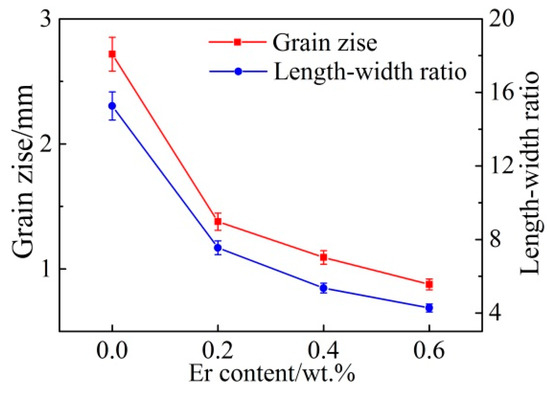
Figure 7.
Refinement effect of Er addition on prior β grains size and the ratio of length to width of α lath.
Figure 8 shows the SEM images of Ti6Al4V-xEr casting alloys. It is confirmed in Figure 8a that the microstructure of the Er-free baseline alloy had a coarse Widmanstatten structure, that is, fine-grained lamellar matrix of alternating α and β, and an addition of 0.2 wt % Er caused the lamellar structure to coarsen and thicken as seen in Figure 8b. With increasing the Er addition up to 0.4 wt %, fine dispersions precipitated, that is, the light phase as marked by the arrows in Figure 8c and the inset, which could contain high Er content. There occurred more such precipitates with Er being added to 0.6 wt %, seen in Figure 8d.
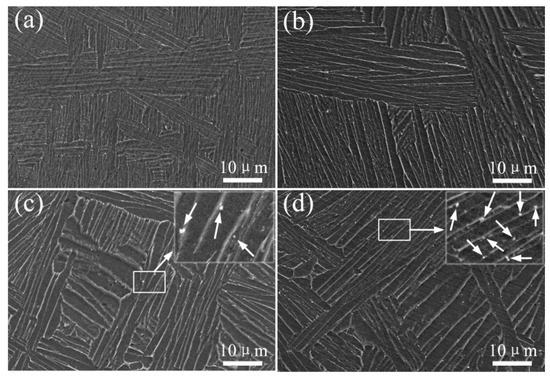
Figure 8.
SEM images of Ti6Al4V-xEr casting alloys: (a) x = 0; (b) x = 0.2; (c) x = 0.4; (d) x = 0.6 wt %.
Further microstructural examination of the fine dispersions was carried out for Ti6Al4V-0.6Er casting alloy by TEM. As shown in Figure 9a, most of the dispersions, marked by the white arrows, were in size of hundreds of nanometers and largely distributed around the β phase and near the grain boundaries. Figure 9b,c shows the morphologies of the dispersions in more details, whereas the corresponding selected area electron diffraction (SAED) of the phases are presented in the insets. In Figure 9b, the two sets of diffraction patterns were calibrated to be Er2O3 with lattice parameters of a = b = c = 10.548Å and the diffraction spots of crystal orientations were along the [03] and [1] directions, respectively. It is well known that the binding force between atoms increases with increasing electronegativity difference [21]. According to Allen electronegativity [22], the electronegative values of Ti, Al, V, O and Er are 1.54, 1.61, 1.53, 3.61 and 1.24, respectively. Because the electronegativity difference of oxygen with erbium is the largest, it is thus easiest to form an oxide between them [23], that is, Er2O3 in this alloy. While in Figure 9c, the SAED revealed that the crystal structure of fine irregular dispersions was simple cubic with lattice parameters of a = b = c = 7.793Å, together with the Al–Er binary phase diagram [24], concluding that it is Al2Er phase. During casting and solidification, once oxygen as an impurity was consumed, erbium then tends to react with other element(s) to form intermetallic compound. Since the electronegativity difference between aluminum and erbium is the second greatest, the formation of Al–Er intermetallic, that is, Al2Er in this case, would be thus favored.
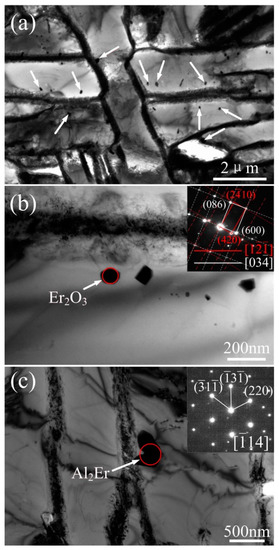
Figure 9.
(a) TEM images of Ti6Al4V-0.6Er casting alloy; (b) enlarged view of Er2O3 phase; and (c) Al2Er phase. The insets show the selected area diffraction patterns of the two phases.
It is well known that the mechanism of grain refinement requires two components: nuclei and solute [25]. Potent nuclei activate nucleation at low undercoolings whereas the solute provides constitutional undercooling allowing activation of adjacent nuclei. The faster a constitutionally undercooled zone develops, the sooner further nucleation will occur ahead of an advancing solid–liquid interface and thus the smaller the resulting grain size [9]. The formation of two Er-containing intermediate phases (Er2O3 and Al2Er), together with a fact of minor Er addition, principally implies a low solubility of Er in β phase of Ti6Al4V-xEr alloys. Those fine precipitates would act as preferential heterogeneous nucleation sites of new α phase and grow independently, which thus pins the migration of grain boundaries of β phase, leading to the refining of the prior β grain size. In addition, erbium, as a RE element, can reduce the surface tension of the melts due to its surface activity and thus decrease the fluctuated energy needed for the formation of critical grain nuclei. Consequently, both the probability and the growth rate of nucleation are enhanced, which increases the tendency to the breakup of primary dendrites and their side-branches, thus being beneficial to the refining effect of grains.
3.2. Mechanical Properties
Table 2 shows the mechanical properties of Ti6Al4V-xEr casting alloys at room temperature. The effect of the Er addition on the Vickers hardness of Ti6Al4V-xEr casting alloys is illustrated in Figure 10. Note that as the Vickers hardness of Ti6Al4V baseline alloy was 2939 MPa, by increasing Er content, the hardness of the alloy increased gradually, and reached 3132 MPa with 0.6 wt % Er addition.

Table 2.
Room temperature mechanical properties of Ti6Al4V-xEr casting alloys
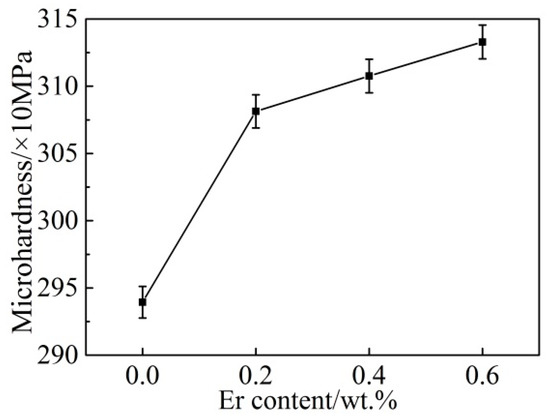
Figure 10.
Vickers hardness of Ti6Al4V-xEr casting alloys.
Room temperature tensile properties and stress–strain curves of Ti6Al4V-xEr casting alloys are shown in Figure 11a,b, respectively. The ultimate tensile strength (Rm), 0.2% yield strength (Rp0.2), elongation (A) and the reduction of area (Z) of Ti6Al4V baseline alloy at room temperature were 792 MPa, 776 MPa, 7.3% and 32.4%, respectively. Note that the strength of Ti6Al4V-0.2Er alloy was evidently enhanced by addition of Er; specifically, the ultimate tensile strength and 0.2% yield strength were promoted to 830 and 787 MPa, respectively. In contrast, further increasing Er content led to a decrease of the strength; the ultimate tensile strength and 0.2% yield strength of Ti6Al4V-0.4Er alloy were reduced to 804 and 747 MPa, and became 788 and 730 MPa with 0.6 wt % Er, respectively. The similar tendency of Er addition on plasticity of Ti6Al4V-xEr alloys was also observed; for example, the elongation firstly increased to 10.6% by 0.2 wt % Er addition and then dropped to 6.1% by 0.6 wt % Er addition. Moreover, the reduction of area of Ti6Al4V-0.2Er alloy was 45.1%, then a slight decrease (42.5%) with 0.4% Er addition, and finally a rapid reduction to 18% with 0.6 wt % Er addition. In brief, the Ti6Al4V-0.2Er alloy exhibits optimal mechanical properties, with the highest strength and acceptable plasticity in comparison with its baseline alloy and other modified counterparts.
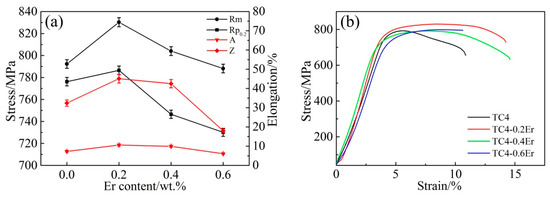
Figure 11.
(a) Room temperature tensile properties of Ti6Al4V-xEr casting alloys; (b) stress–strain curves of Ti6Al4V-xEr casting alloys.
Ti6Al4V-0.2Er alloy has higher strength and better plasticity than Ti6Al4V alloy because of the grain refinement effect of the trace Er element addition. It is due to the fact that when more grains get involved, there are fewer dislocations accumulated in each grain, and the cracking opportunities caused by stress concentration are reduced. The alloy can withstand a larger amount of deformation before fracture, thus enhancing the strength and plasticity. It can be learned from Figure 7 that by further increasing Er content, the grain refinement effect was slowed down, and it in turn resulted in the increase of Er-enriched precipitates in size. Nevertheless, large second-phase particles, especially the insoluble ones, usually make no substantial contribution to the yield strength of the alloy [26]. Therefore, the strength and plasticity of Ti6Al4V-xEr alloys with higher Er contents were not as high as those of the Ti6Al4V-0.2Er alloy.
Figure 12 displays the micro-fractographies of Ti6Al4V-xEr alloys with different Er contents. From Figure 12a, it is apparent that shallow dimples on fracture surface of Ti6Al4V baseline alloy were uniformly distributed, and the cross section was intergranular fracture. In the tensile fracture morphology of Ti6Al4V-0.2Er alloy, dimples become larger and deeper, and cleavage planes appear on the section, which was a mixed mode of intergranular and trans-granular fracture. As shown in Figure 12c,d, there were cleavage steps and tearing edges on the fracture surfaces. In addition, a large number of small shallow dimples and some long strip fracture planes can also be observed in Ti6Al4V-0.4Er and Ti6Al4V-0.6Er alloys. Through comparative analysis, the long strip fracture was revealed to correspond to lamellar α phase in the microstructure of the alloys.
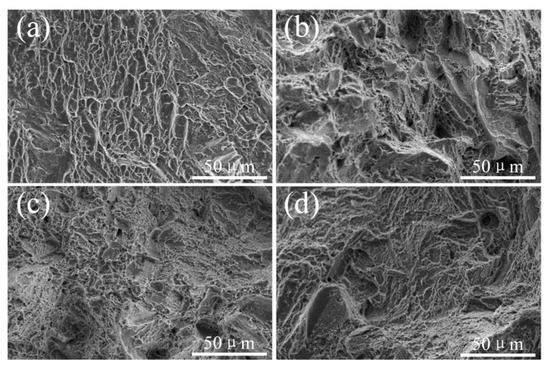
Figure 12.
Micro-fractography of Ti6Al4V-xEr casting alloys: (a) x = 0; (b) x = 0.2; (c) x = 0.4; (d) x = 0.6 wt %.
4. Conclusions
Effects of trace erbium addition on microstructure and properties of as-cast Ti6Al4V-xEr alloys had been investigated in this paper. Based on the experimental results, the following conclusions could be drawn:
(1) The addition of Er elements has a remarkable refinement effect on the grain size and microstructure of Ti6Al4V alloy. The grain size of the original Ti6Al4V alloy was 2.72 mm and it was reduced to about 0.88 mm by the 0.6 wt % Er additives.
(2) Er reacted with O and Al to form Er2O3 and Al2Er particles with much finer size distributed mainly around the β phase and near grain boundaries. In addition, these particles could act as heterogeneous nucleus and are capable of preventing grain growth.
(3) An increase in both strength and plasticity with increasing Er content was obtained but followed by a drop, while a gradual monotonous improvement in hardness was achieved. The Ti6Al4V-0.2Er alloy exhibits optimal mechanical properties.
Author Contributions
Conceptualization, H.C. and Y.C.; methodology, Y.G. and G.X.; validation, Y.G. and G.X.; formal analysis, Y.W.; investigation, Y.W.; data curation, Y.W.; writing—original draft preparation, Y.W.; writing—review and editing, Y.G.; visualization, Y.G. and Y.W.; supervision, H.C. and Y.C.; project administration, Y.G.; funding acquisition, Y.C., G.X. and Y.G.
Funding
This research was funded by the Defense Industrial Technology Development Program of China [No. JCKY2018414C020]. Y.C. acknowledges the support from the Natural Science Funds of China [Grant No. 51571113], G.X. was funded by the Natural Science Funds of China [Grant No. 51701094] and the Natural Science Funds of Jiangsu Province [Grant No. BK20171014]. Y.G. would like to thank the support from the National Natural Science Foundation of China (No. 11647162) and Priority Academic Program Development of Jiangsu Higher Education Institution (PAPD).
Conflicts of Interest
The authors declare no conflict of interest.
References
- Dizlek, M.E.; Guden, M.; Turkan, U.; Tasdemirci, A. Processing and compression testing of Ti6Al4V foams for biomedical applications. J. Mater. Sci. 2009, 44, 1512–1519. [Google Scholar] [CrossRef]
- Gopal, J.; George, R.P.; Muraleedharan, P.; Kalavathi, S.; Banerjee, S.; Dayal, R.K.; Khatak, H.S. Photocatalytic inhibition of microbial fouling by anodized Ti6Al4V alloy. J. Mater. Sci. 2007, 42, 5152–5158. [Google Scholar] [CrossRef]
- Vaidya, W.V.; Horstmann, M.; Ventzke, V.; Petrovski, B.; Koçak, M.; Kocik, R.; Tempus, G. Improving interfacial properties of a laser beam welded dissimilar joint of aluminium AA6056 and titanium Ti6Al4V for aeronautical applications. J. Mater. Sci. 2010, 45, 6242–6254. [Google Scholar] [CrossRef]
- Stanford, N.; Carlson, U.; Barnett, M.R. Deformation twinning and the hall–petch relation in commercial purity Ti. Metall. Mater. Trans. A 2008, 39, 934–944. [Google Scholar] [CrossRef]
- Filip, R.; Kubiak, K.; Ziaja, W.; Sieniawski, J. The effect of microstructure on the mechanical properties of two-phase titanium alloys. J. Mater. Process. Technol. 2003, 133, 84–89. [Google Scholar] [CrossRef]
- Tamirisakandala, S.; Bhat, R.B.; Tiley, J.S.; Miracle, D.B. Processing, microstructure, and properties of β titanium alloys modified with boron. J. Mater. Eng. Perform. 2005, 14, 741–746. [Google Scholar] [CrossRef]
- Jia, L.; Liang, Z.; Xu, D.; Guo, J. Effects of centrifugal forces and casting modulus on structures and mechanical properties of Ti-6Al-4V alloy. Rare Metal Mater. Eng. 2016, 45, 581–587. [Google Scholar] [CrossRef]
- Khorev, A.I. Alloying and heat treatment of structural (α + β) titanium alloys of high and superhigh strength. Russ. Eng. Res. 2010, 30, 682–688. [Google Scholar] [CrossRef]
- Bermingham, M.J.; Mcdonald, S.D.; Stjohn, D.H.; Dargusch, M.S. Segregation and grain refinement in cast titanium alloys. J. Mater. Res. 2009, 24, 1529–1535. [Google Scholar] [CrossRef]
- Bermingham, M.J.; McDonald, S.D.; Dargusch, M.S.; StJohn, D.H. The mechanism of grain refinement of titanium by silicon. Scr. Mater. 2008, 58, 1050–1053. [Google Scholar] [CrossRef]
- Tamirisakandala, S.; Bhat, R.B.; Tiley, J.S.; Miracle, D.B. Grain refinement of cast titanium alloys via trace boron addition. Scr. Mater. 2005, 53, 1421–1426. [Google Scholar] [CrossRef]
- Yu, J.; Zhao, Z.J.; Li, L.X. Corrosion fatigue resistances of surgical implant stainless steels and titanium alloy. Corros. Sci. 1993, 35, 587–597. [Google Scholar] [CrossRef]
- Early, P.W.; Burns, S.J. Improved toughness from prior beta grains in Ti6Al4V. Scr. Metall. 1977, 11, 0–869. [Google Scholar] [CrossRef]
- Tang, H.F.; Zhao, Y.Q.; Hong, Q.; Zeng, L.Y. Effects of rare earth elements on the structure and properties of high-temperature titanium alloy. Titanium Ind. Prog. 2010, 27, 16–21. [Google Scholar]
- Deng, J.; Yang, G.J. Role of rare earth elements in titanium and its alloys. Rare Metal Mater. Eng. 1993, 22, 1–11. [Google Scholar]
- Liu, Z.G.; Zhang, C.J.; Chai, L.H.; Chen, Y.Y.; Woo, K.D. Effect of Y on microstructure and mechanical properties of a Ti alloy. Mater. Sci. Forum 2010, 654–656, 460–463. [Google Scholar] [CrossRef]
- Xiao, W.L.; Wu, S.Q.; Ping, D.H.; Murakami, H.; Yamabe-Mitarai, Y. Effects of Sc addition on the microstructure and tensile properties of Ti–6.6Al–5.5Sn–1.8Zr alloy. Mater. Chem. Phys. 2012, 136, 1015–1021. [Google Scholar] [CrossRef]
- Ke, Y.; Duan, H.; Sun, Y. Effect of yttrium and erbium on the microstructure and mechanical properties of Ti–Al–Nb alloys. Mater. Sci. Eng. A 2010, 528, 220–225. [Google Scholar] [CrossRef]
- Whitsett, C.R.; Sastry, S.M.L.; Oneal, J.E.; Lederich, R.J. Influence of Rare-Earth Additions on Properties of Titanium Alloys Microstructures and Room-Temperature Tensile Properties of Ti-6Al-4V with Yttrium, Erbium and Mischmetal Additions. Tech. Rep. 1977, 1, 76–77. [Google Scholar]
- Burgers, W.G. On the process of transition of the cubic-body-centered modification into the hexagonal-close-packed modification of zirconium. Physica 1934, 1, 561–586. [Google Scholar] [CrossRef]
- Chen, Y.; Kong, F.; Han, J.; Chen, Z.; Tian, J. Influence of yttrium on microstructure, mechanical properties and deformability of Ti–43Al–9V alloy. Intermetallics 2005, 13, 263–266. [Google Scholar] [CrossRef]
- Allen, L.C. Electronegativity is the average one-electron energy of the valence-shell electrons in ground-state free atoms. J. Am. Chem. Soc. 1989, 111, 9003–9014. [Google Scholar] [CrossRef]
- Wang, X.; Ma, X.; Nie, Q.; Wang, M. Effects of y addition on microstructure and mechanical properties of TiC/Ti6Al4V composites. Intermetallics 2012, 31, 242–248. [Google Scholar] [CrossRef]
- Pan, Y.; Yang, W.; Tang, C.; Lan, Y.; Zhan, Y.Z. Phase diagram of the Al–Er–Mo ternary system at 873 K. Phase Transitions 2015, 88, 1111–1121. [Google Scholar] [CrossRef]
- Easton, M.; Stjohn, D. An analysis of the relationship between grain size, solute content, and the potency and number density of nucleant particles. Metall. Mater. Trans. A 2005, 36, 1911–1920. [Google Scholar] [CrossRef]
- Huang, K.; Marthinsen, K.; Zhao, Q.L.; Logé, R.E. The double-edge effect of second-phase particles on the recrystallization behaviour and associated mechanical properties of metallic materials. Prog. Mater. Sci. 2018, 92, 284–359. [Google Scholar] [CrossRef]
© 2019 by the authors. Licensee MDPI, Basel, Switzerland. This article is an open access article distributed under the terms and conditions of the Creative Commons Attribution (CC BY) license (http://creativecommons.org/licenses/by/4.0/).